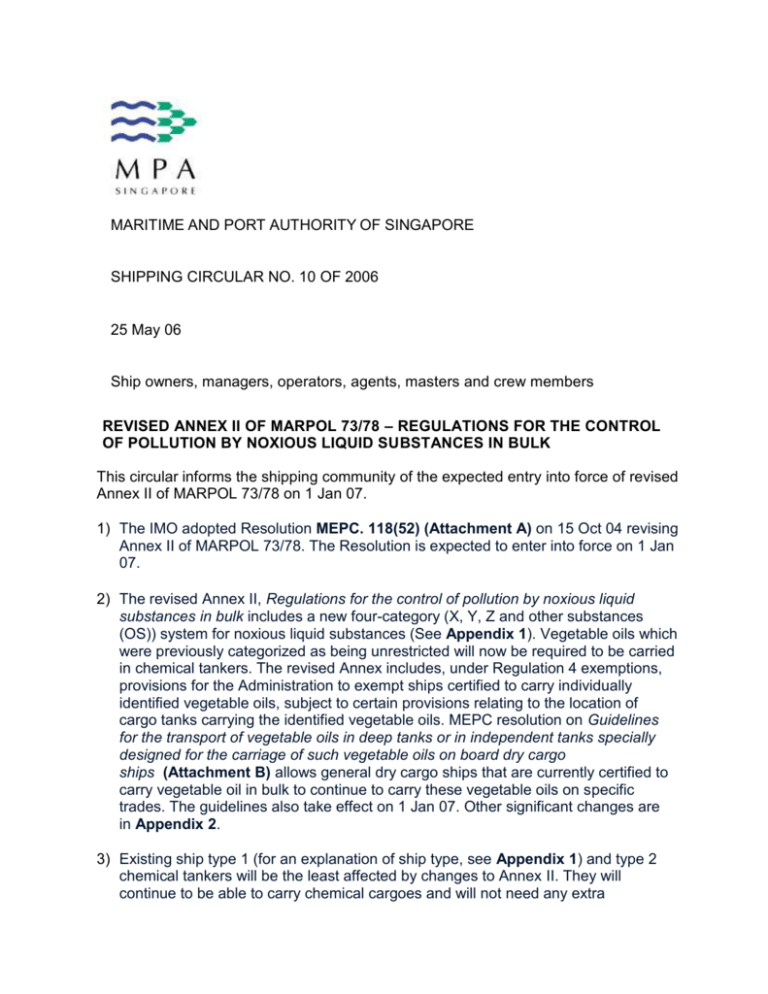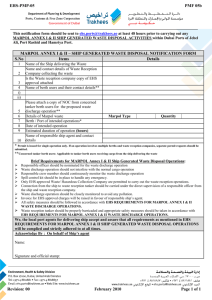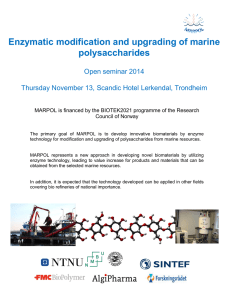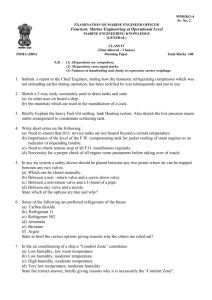MARITIME AND PORT AUTHORITY OF SINGAPORE SHIPPING
advertisement

MARITIME AND PORT AUTHORITY OF SINGAPORE SHIPPING CIRCULAR NO. 10 OF 2006 25 May 06 Ship owners, managers, operators, agents, masters and crew members REVISED ANNEX II OF MARPOL 73/78 – REGULATIONS FOR THE CONTROL OF POLLUTION BY NOXIOUS LIQUID SUBSTANCES IN BULK This circular informs the shipping community of the expected entry into force of revised Annex II of MARPOL 73/78 on 1 Jan 07. 1) The IMO adopted Resolution MEPC. 118(52) (Attachment A) on 15 Oct 04 revising Annex II of MARPOL 73/78. The Resolution is expected to enter into force on 1 Jan 07. 2) The revised Annex II, Regulations for the control of pollution by noxious liquid substances in bulk includes a new four-category (X, Y, Z and other substances (OS)) system for noxious liquid substances (See Appendix 1). Vegetable oils which were previously categorized as being unrestricted will now be required to be carried in chemical tankers. The revised Annex includes, under Regulation 4 exemptions, provisions for the Administration to exempt ships certified to carry individually identified vegetable oils, subject to certain provisions relating to the location of cargo tanks carrying the identified vegetable oils. MEPC resolution on Guidelines for the transport of vegetable oils in deep tanks or in independent tanks specially designed for the carriage of such vegetable oils on board dry cargo ships1(Attachment B) allows general dry cargo ships that are currently certified to carry vegetable oil in bulk to continue to carry these vegetable oils on specific trades. The guidelines also take effect on 1 Jan 07. Other significant changes are in Appendix 2. 3) Existing ship type 1 (for an explanation of ship type, see Appendix 1) and type 2 chemical tankers will be the least affected by changes to Annex II. They will continue to be able to carry chemical cargoes and will not need any extra equipment. The cargoes which they can carry and the tanks in which they can carry them will, however, be different. For example, vegetable oils previously carried in wing tanks will now have to be carried in ship type 2 side/bottom protected tanks. The procedures and arrangement manual of the ship will need to be amended to take into account the new categories and the cargo list will need to be amended and reissued. 4) Existing ship type 3 chemical tankers will no longer be allowed to carry vegetables oils unless the ship meets certain side/bottom requirements to satisfy the vegetable oil waiver described above (Regulation 4). 5) Stripping tests will now be necessary for the carriage of any pollution category 'Z' cargoes on a chemical tanker. 6) Existing product tankers carrying International Bulk Chemical (IBC) Code chapter 18 cargoes will continue to be able carry these cargoes, but there will be fewer of them and most cargoes traditionally carried in large quantities, such as vegetable oils, will no longer be permitted. 7) As a Party to the MARPOL Convention, Singapore has treaty obligations to give effect to the revised Annex II. Ship owners are advised to approach the nine approved classification societies to seek further guidance and to assess whether making minor or major modifications to enable the carriage of additional cargoes is cost effective or technically feasible. The conversion of a product tanker to a chemical tanker, for example, to carry vegetable oils, although difficult, could be a viable option for some ship owners. Shipping community is urged to take early action to comply with the revised Annex II by 1 Jan 07. 8) Any queries relating to this circular should be directed to Mr Zafrul Alam (Tel: 63756204). KHONG SHEN PING DIRECTOR OF MARINE MARITIME AND PORT AUTHORITY OF SINGAPORE Appendix 1 REVISED MARPOL ANNEX II 4 New Categories The new categories are: 1. Category X: Noxious Liquid Substances which, if discharged into the sea from tank cleaning or deballasting operations, are deemed to present a major hazard to either marine resources or human health and, therefore, justify the prohibition of the discharge into the marine environment; 2. Category Y: Noxious Liquid Substances which, if discharged into the sea from tank cleaning or deballasting operations, are deemed to present a hazard to either marine resources or human health or cause harm to amenities or other legitimate uses of the sea and therefore justify a limitation on the quality and quantity of the discharge into the marine environment; 3. Category Z: Noxious Liquid Substances which, if discharged into the sea from tank cleaning or deballasting operations, are deemed to present a minor hazard to either marine resources or human health and therefore justify less stringent restrictions on the quality and quantity of the discharge into the marine environment; and 4. Other Substances: substances which have been evaluated and found to fall outside Category X, Y or Z because they are considered to present no harm to marine resources, human health, amenities or other legitimate uses of the sea when discharged into the sea from tank cleaning of deballasting operations. The discharge of bilge or ballast water or other residues or mixtures containing these substances are not subject to any requirements of MARPOL Annex II. Ship type (1, 2 or 3) Chemical tankers are generally referred to by their ship type (1, 2 or 3). This is a parameter based on a vessel's cargo tank configuration and its ability to withstand collision or grounding damage. It gives a measure of the potential hazard of the cargoes which a ship is able to carry, e.g. ship type 2 cargoes are more hazardous than ship type 3 cargoes. Appendix 2 Other Significant Changes Under Revised MARPOL Annex II 1. Improvements in ship technology, such as efficient stripping techniques, have made possible significantly lower permitted discharge levels of certain products which have been incorporated into Annex II. For ships constructed on or after 1 January 2007 the maximum permitted residue in the tank and its associated piping left after discharge will be set at a maximum of 75 litres for products in categories X, Y and Z - compared with previous limits which set a maximum of 100 or 300 litres, depending on the product category. 2. Alongside the revision of Annex II, the marine pollution hazards of thousands of chemicals have been evaluated by the Evaluation of Hazardous Substances (EHS) Working Group, giving a resultant GESAMP2 Hazard Profile which indexes the substance according to its bio-accumulation; bio-degradation; acute toxicity; chronic toxicity; long-term health effects; and effects on marine wildlife and on benthic habitats. 3. Consequential amendments to the International Bulk Chemical Code (IBC Code) were also adopted, reflecting the changes to MARPOL Annex II. The amendments incorporate revisions to the categorization of certain products relating to their properties as potential marine pollutants as well as revisions to ship type and carriage requirements following their evaluation by the EHS Working Group. 4. Ships constructed after 1986 carrying substances identified in chapter 17 of the IBC Code must follow the requirements for design, construction, equipment and operation of ships contained in the Code.






